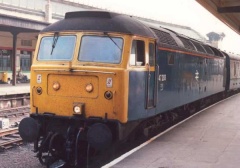Brush Type 4
From PikkaWiki
(Difference between revisions)
(New page: The '''Brush Type 4''' is a diesel locomotive in the UK Railway Set. ==Statistics and information== [[Image:47.png|right|Seven livery variations, based on ye...) |
|||
| Line 35: | Line 35: | ||
==Prototype information== | ==Prototype information== | ||
[[Image:47.jpg|left|240px]]The [http://en.wikipedia.org/wiki/British_Rail_Class_47 Class 47] was a major standard locomotive of the late 20th century. With high top speed, power and tractive effort, it was a real master of all trades. Many still serve with minor operators or as "Thunderbird" rescue locomotives today, many re-engined as Class 57. | [[Image:47.jpg|left|240px]]The [http://en.wikipedia.org/wiki/British_Rail_Class_47 Class 47] was a major standard locomotive of the late 20th century. With high top speed, power and tractive effort, it was a real master of all trades. Many still serve with minor operators or as "Thunderbird" rescue locomotives today, many re-engined as Class 57. | ||
| + | |||
| + | ==Similar locomotives== | ||
| + | The [http://en.wikipedia.org/wiki/British_Rail_Class_50 Class 50] was a slightly later English Electric locomotive of similar power and appearance. | ||
{{PJ1K}} | {{PJ1K}} | ||
[[Category:Locomotives]] | [[Category:Locomotives]] | ||
[[Category:Vehicles which were in TTO]] | [[Category:Vehicles which were in TTO]] | ||
Revision as of 21:07, 26 July 2010
The Brush Type 4 is a diesel locomotive in the UK Railway Set.
Statistics and information
| Type: | Heavy General Purpose Diesel |
|---|---|
| Introduction: | 1962 |
| Withdrawal: | 2030 |
| Speed: | 95mph |
| Power: | 2580hp |
| Weight: | 120t |
| Tractive Effort: | 267kN |
| Replaces: | Sulzer Type 4 |
| Replaced By: | EMD Class 66, EMD Class 67 |
Prototype information
The Class 47 was a major standard locomotive of the late 20th century. With high top speed, power and tractive effort, it was a real master of all trades. Many still serve with minor operators or as "Thunderbird" rescue locomotives today, many re-engined as Class 57.Similar locomotives
The Class 50 was a slightly later English Electric locomotive of similar power and appearance.

